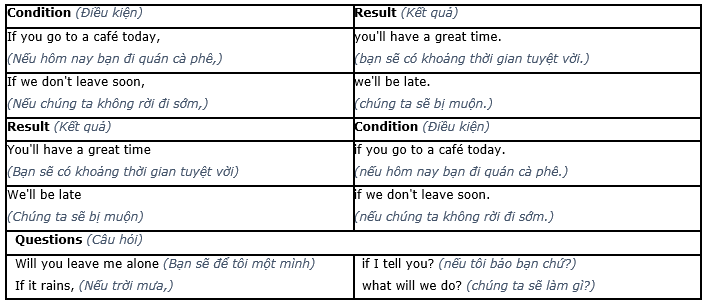
Hãy nhập câu hỏi của bạn vào đây, nếu là tài khoản VIP, bạn sẽ được ưu tiên trả lời.


1. wearing
2. having
3. doing
4. dancing
5. sitting
Rules:
1. wearing, doing (playing, sleeping, walking, watching)
2. having, dancing (moving)
3. sitting
Tạm dịch:
QUY TẮC CHÍNH TẢ |
1. Hầu hết động từ: +-ing study → studying eat →eating play →playing 2. Những động từ tận cùng là e: bỏ e +-ing move → moving take → taking practise → practising 3. Những động từ tận cùng là phụ âm + nguyên âm: gấp đôi phụ âm cuối + -ing chat → chatting plan → planning stop →stopping |

1. Don’t talk in class.
(Không nói chuyện trong lớp.)
2. Don’t eat in class.
(Không ăn trong lớp.)
3. Finish the homework before the lessons.
(Hoàn thành bài tập về nhà trước giờ học.)
4. Listen to the teachers.
(Nghe lời thầy cô giáo.)
5. Clean the classroom everyday.
(Dọn dẹp lớp học hàng ngày.)

RULES (Quy tắc) |
We use might when don't know if something is true. (Chúng ta sử dụng might khi chúng ta không biết điều gì đó có đúng hay không.) The he/she/it forms of might are the same. (Dạng he/she/it của might đều giống nhau.) |

RULES (QUY TẮC)
1. Regular verbs have got past simple forms ending in -ed.
(Động từ có quy tắc có hình thức quá khứ đơn kết thúc là -ed.)
2. Irregular verbs haven't got past simple forms ending in -ed.
(Động từ bất quy tắc không có hình thức quá khứ đơn kết thúc bằng -ed.)
3. Verbs in the past simple have got the same form for I, you, he, she, it, we and they.
(Các động từ ở quá khứ đơn có cùng dạng với I, you, he, she, it, we và they.)

RULES (Quy tắc)
1. We use the first conditional to talk about a condition in the future and the result of this condition.
(Chúng ta sử dụng điều kiện loại 1 để nói về một điều kiện trong tương lai và kết quả của điều kiện này.)
2. We describe the condition with if + present simple.
(Chúng ta mô tả điều kiện với if + thì hiện tại đơn.)
3. We describe the result with will + infinitive.
(Chúng ta mô tả kết quả với will + động từ nguyên thể.)
4. The sentence can start with the condition or the result. If it starts with the result, we don't use a comma.
(Câu có thể bắt đầu bằng điều kiện hoặc kết quả. Nếu nó bắt đầu bằng kết quả, chúng ta không sử dụng dấu phẩy.)
5. We never use if + will: If you will go, I'll be happy.
(Chúng ta không bao giờ sử dụng if + will.)

1. These students are studying.
(Những học sinh này đang học.)
2. The boat isn’t moving.
(Chiếc thuyền không di chuyển.)
3. Her students are staying at at home and learning the lessons on television.
(Học sinh đang ở nhà và học bài trên truyền hình.)
4. I'm watching the dancers.
(Tôi đang ngắm các vũ công.)
RULES |
1. The present continuous talks about things happening now. (Thì hiện tại tiếp diễn nói về những sự việc đang xảy ra ở hiện tại.) 2. We form the present continuous with the verb be. (Chúng ta hình thành thì hiện tại tiếp diễn với động từ be.) 3. We add -ing to the main verb. (Chúng ta thêm –ing vào động từ chính.) |

Staunton style chess pieces. Left to right:king, rook, queen, pawn, knight, bishop
The rules of chess (also known as the laws of chess) are rules governing the play of the game of chess. While the exact origins of chess are unclear, modern rules first took form during the Middle Ages. The rules continued to be slightly modified until the early 19th century, when they reached essentially their current form. The rules also varied somewhat from place to place. Today, the standard rules are set by FIDE (Fédération Internationale des Échecs), the international governing body for chess. Slight modifications are made by some national organizations for their own purposes. There are variations of the rules for fast chess, correspondence chess, online chess, and Chess960.
Chess is a two-player board game utilizing a chessboard and sixteen pieces of six types for each player. Each type of piece moves in a distinct way. The goal of the game is to checkmate (threaten with unescapable capture) the opponent's king. Games do not necessarily end with checkmate; players often resign if they believe they will lose. A game can also end in a draw in several ways.
Besides the basic moves of the pieces, rules also govern the equipment used, time control, conduct and ethics of players, accommodations for physically challenged players, and recording of moves using chess notation. Procedures for resolving irregularities that can occur during a game are provided as well.